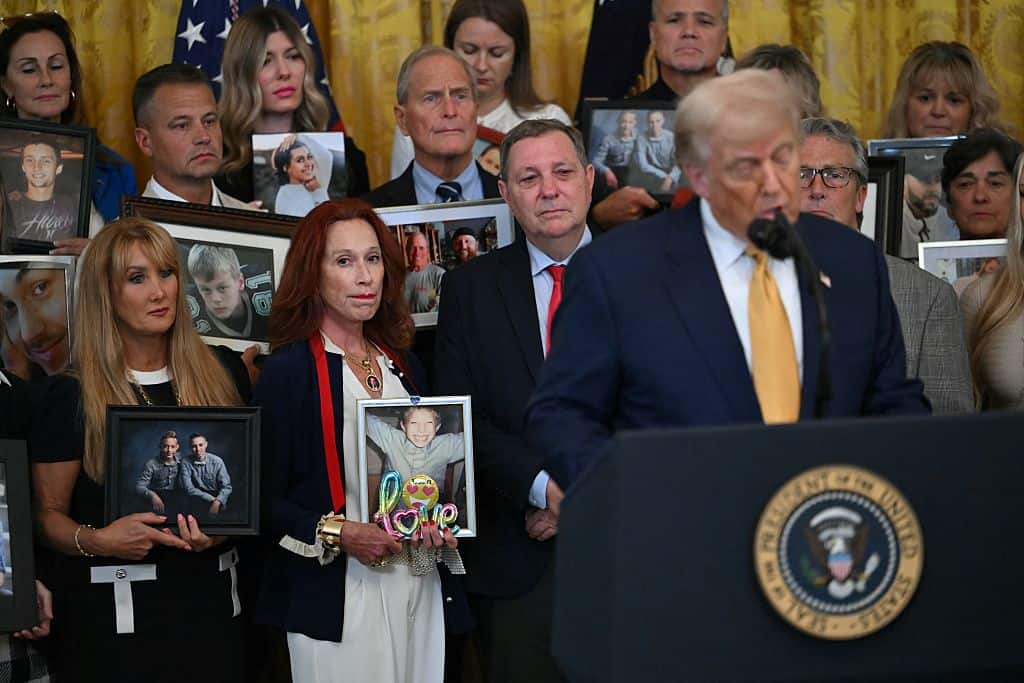The Fentanyl Crisis is Destroying Families – Part One

The recent July 16 signing of the HALT Fentanyl Act into law is a huge win for American families and communities. It classifies fentanyl as a Schedule I drug as defined by the Controlled Substances Act. This increases the penalty for fentanyl related offenses, imposes a mandatory minimum 10-year prison term and provides new deterrence to dealing fentanyl, keeping dealers off the streets.
Why is this such a big win for parents, families, and communities?
Fentanyl overdose is the number one cause of death for Americans 18-45, impacting families and communities across the country every day. In 2024, there were 80,391 reported deaths from drug overdoses in the U.S.; over half of those were the result of fentanyl and its analogues.
Despite its far reaching and devastating impacts, many Americans today primarily associate fentanyl overdose with the results of deliberate (albeit motivated by addiction) illicit drug use.
While tragic, Americans can wrongly dismiss the fentanyl crisis as unlikely to impact their family. Unexpected fentanyl overdose can have a sudden impact on anyone, any family and any community due to its potency and the fact that fentanyl can be easily hidden in multiple substances.

A reported 31.9% of 13 to 18 year-olds are found to deal with anxiety, making them particularly susceptible to peer pressure. This is where fentanyl can be unexpectedly dangerous. According to a 2022 study from the CDC, only 27.5% of teens reported that they always receive the social and emotional support they need while 76.9% of parents reported that they believed that their teens did always have the social and emotional support they need.
Whether the cause of this discrepancy is parents not paying enough attention to their children, or children deliberately hiding their struggles from their parents, it highlights a significant point: parents are often completely unaware that their teens are struggling.
Anxiety, depression, and mental illness can cause people to make rash and out of character decisions, often motivated by desperation, fear, panic, and embarrassment. Especially for teens, peer pressure can also be a factor in seeking out solutions they ordinarily would not pursue. This is where fentanyl can be especially and unexpectedly dangerous.
Xanax, the brand name for the drug Alprazolam, is one of the most popular prescription anxiety medications on the market. Under the right circumstances – and a legitimate prescription, it can help provide relief.
In the last ten years, however, counterfeit pills laced with – or entirely made of – fentanyl have emerged. Xanax has become one of most common drugs for recreation with illicit synthetic opioids. Whether motivated by perceived embarrassment of consulting with a parent or doctor, ease of availability, or another factor, teens looking for relief are turning to pills coming from unverified sources.
In 2015, at least one person died and eight more were hospitalized in San Francisco after taking fake Xanax pills laced with fentanyl. A report by Dr. Ann Arens found “[the pills] looked very similar to prescription Xanax, down to bearing the same pharmaceutical markings as the legitimate anxiety drug. … The users that were exposed to these tablets had no idea it was anything other than what they thought they were buying.”
In 2019, 24-year-old Travis Jacobson acquired Xanax from someone he knew from high school in order to be relaxed before an important job interview he was supposed to have the next day. He never made it to the interview. He was found dead in his Los Angeles apartment the next day. Cause of death: fentanyl overdose.
Similarly, in Hollywood, Florida, 21-year-old Melissa Hernandez bought what she believed to be Xanax on the street, which lead to her 2021 death from fentanyl overdose. “She was a very good student. She really liked drawing and art. She was really popular in high school,” her father said.
These are just a few tragic instances of the many cases like them occurring across the nation. But Xanax is not the only example; counterfeit aspirin, Aleve and Adderall among many others are also known to be laced with fentanyl.
Fentanyl overdose can touch any family, any community and any type of person.
The HALT Fentanyl Act is a good initial step, however, a crisis of this scale must also be attacked at the root.
What really is at the root of the problem? Check back soon for part two in this series for additional solutions to the fentanyl crisis.
Related Articles and Resources:
Resources: Substance Abuse & Addiction
The Opioid Epidemic—Think Your Family Is Immune?
Offering Hope to Families Experiencing Drug Addiction
Helping Kids Avoid Opioid Addiction
New Law Increases Penalties for Manufacturing, Distributing Fentanyl
Nation Fentanyl Awareness Day Highlights Rates of Unintentional Overdoses in Young People
Photo from Getty Images.
ABOUT THE AUTHOR

Allison Engle is a senior at Liberty University majoring in International Relations & Strategic Intelligence Studies and minoring in Spanish. She is a Team Chief for the Liberty Analytical Support Initiative and an alumna of the Young Leaders Program at the Heritage Foundation where she worked in the Center for National Security. She is passionate about National Security, Economic, and Foreign Policy, and its impacts on people, families, and communities. She is currently the Global Studies Intern at Focus on the Family.
Related Posts

Governor Gavin Newsom Becomes a ‘Christian Nationalist’
November 6, 2025

What to Do When God is Silent
March 26, 2025


